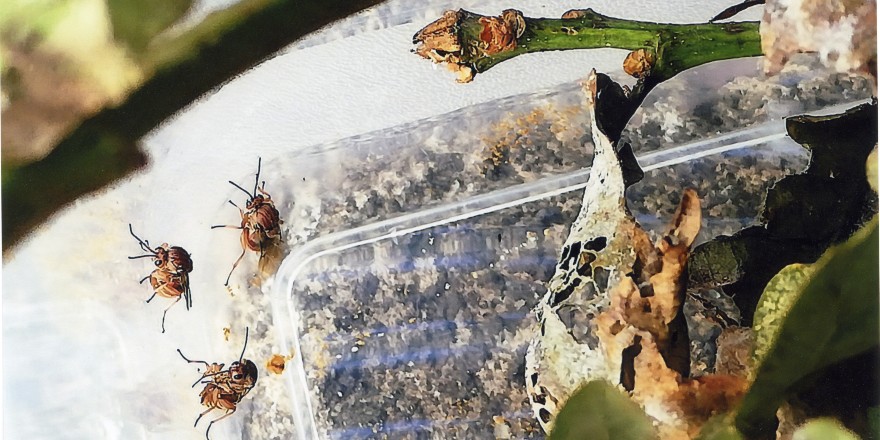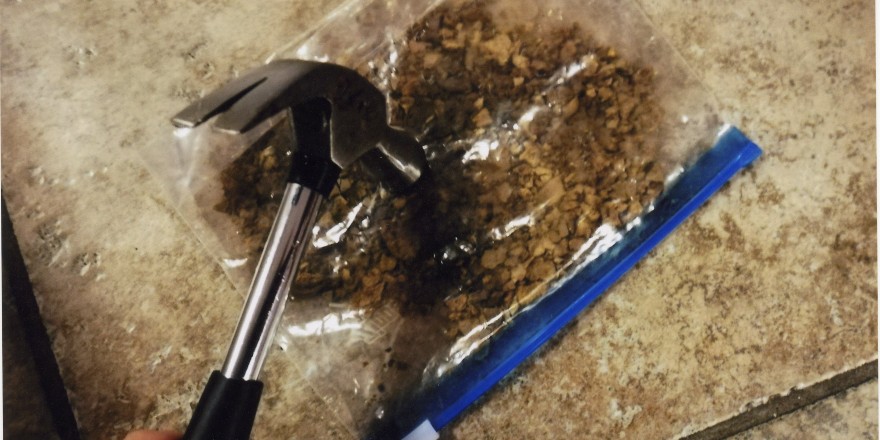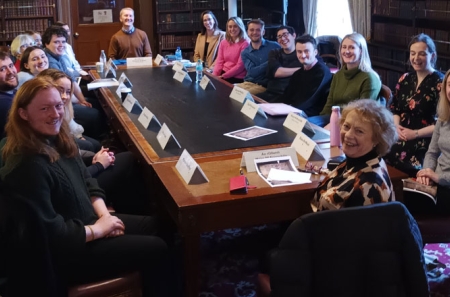
Memories, manuscripts and medieval ink
23 April 2020Library Blog post. After a visit to the Library last year, Kathleen Reen was inspired to learn more about how the old scribes made ink. Follow Kathleen on her journey.
How often we say 'Send me a note' or even 'Text me'. It all seems so easy.
How can unlikely things like Bus-Pass, Uni-slim, Japanese Knotweed be linked to the Cathach? But all things are possible for a mind such as mine, which wanders, meanders, ambles, races, hither and tither.
Like all children in the 50s, I had read at school the story of St Columba, and that he had magically in a single night copied a borrowed manuscript, the ensuing row over keeping the copy, his exile to Iona (in fourth class, learning to spell 'exile'!), not being allowed to let his feet touch Irish soil, his cleverness at tying sods of Scottish turf to his feet so that he could return to Ireland and keep to the letter of his exile. (I wasn’t so sure about the honesty of that, I was going through a scrupulous stage myself. In that era even a child could be said to suffer from 'Scruples'). But nobody, nobody, ever mentioned this jewel of a manuscript was still in existence. And in Ireland. And that it could be viewed.
On my first visit to the Royal Irish Academy (RIA), I was researching an ogham stone near Ballyferriter in Co Kerry, Cathair na gCat (Cahernagat SMR ref KE042-093003). I had been working on making 3D images for a local Dingle Peninsula based project (www.corcadhuibhne3D.ie), and I had heard there was a reference in the Windele Collection to this particular ogham stone (Ref. page 939). A sketch by the Rev. James Goodman, dated September 17th 1855, shows the complete stone. It was later broken in the 1880s and the last portion of the lettering lost. The collection contains various letters and opinions on deciphering the ogham. (See also J.Cuppage (1986). ‘Corca Dhuibhne. Dingle Peninsula Archaeological Survey. Ballyferriter: Oidhreacht Chorca Dhuibhne’ no 549. On my return to Ballyferriter, Isabel Bennett, archaeologist with Oidhreacht Chorca Dhuibhne, casually asked me if I had seen the 'Cathach' while I was there. I had to plead ignorance. I had no idea what it was, or even that it existed. Now fuelled with enthusiasm, on my next visit to Dublin I trotted along to the RIA and duly asked at reception 'Can I see the Cathach please?' There followed a cringe factor. I really had absolutely no idea how precious this manuscript was, how vulnerable, what was involved in displaying it, or really anything about it.
But true to form, when I am thwarted in a mission, my resolve is strengthened. And on the next display date, I waited outside the RIA for 15 minutes before opening time so that I could join the queue, but at the same time, not appear too eager. I brought along my son-in-law Reuben. After almost two decades working in Africa, the family had recently settled in Ireland, and I wanted to impress him and show him how cultured his mother-in-law was, and not just a wild woman of the west. It is a bit of an understatement to say Reuben loves books.
There was no queue. There was just us two. There weren’t even any signs or banners at reception. There was just the usual calm, and a nod to indicate we could proceed into the library. I can’t tell you the reverence I felt approaching it. It felt akin to approaching a new-born grandchild, someone familiar but as yet unknown. Sophie Evans gave us a really detailed description. Then she indicated the tiny pin-pricks on one folio, where the scribe had painstakingly used some device or compass to perfectly ornament or inscribe the letter 'M'. I don’t have the terminology relating to the calligraphy, I just know I nearly cried with emotion. So much for impressing Reuben with my nonchalance! Then Sophie went on to explain how the ink was made from oak-galls, etc., but that she had never seen them. Such was my gratitude for her time, I resolved in my mind to send her some should I ever find them, but in truth, with no great belief I ever would.
Let me jump to the 'Bus Pass'. I absolutely love it and the freedom it gives me to hop on and off trains and buses. A warm August afternoon, I needed to travel from Cork to Midleton via train. It’s an hourly service. It shares the line with a train from Cork to Cobh as far as Glounthaune and there the line divides. The trains leave at different times.
A warm afternoon in Kent station, the coffee dock beckons me. But I am never satisfied with just coffee. There are temptations in the line of Danish Pastries, etc. I have very little resolve. 'Lead us not into temptation' I pray to the Uni-slim god, for help in resisting the coffee and pastries and decide instead to travel to Glounthaune, hop off the Cobh train and have a quick walk in the sunshine before hopping on the next train to Midleton.
At various stages along that main Cork-Dublin road, there are signs of the nature, 'Under pain of death, do not touch the Japanese Knotweed' or such like. My garden suffers a similar affliction. So, I stroll along this very pretty stretch of road towards the village, admiring the leafy path and what had been achieved by clever planting on what was virtually a loop created by building a dual-carriageway, and contemplating the dangers of Japanese Knotweed. Meandering, that’s what I was doing, when I spotted an oak-gall on the grass, and looking up saw clusters hanging from the young oak trees, and I thought of my visit to the RIA. The trees were young, the branches low, but just out of reach, so I resolved to come back the next day, armed with a stick and hook them down. But for the moment, I had to high-tail it back to the station to catch my connection to Midleton.

Next morning saw me parked up and self-consciously hooking the branches with a walking stick. I collected those I could reach, being careful not to take all, and leave some in their natural habitat. I could reach about a dozen or so. At this stage any knowledge I had gained came via Google. It appears the oak-gall wasp lays its eggs on an oak tree. A gall forms around them. This is a marble sized and shaped hard brown ball. They look like Maltesers. As the wasp matures and emerges, she/he exits through a tiny hole. On inspecting my oak-galls, I could see that only some had tiny holes. I imagined there was a possibility the other wasps might eat their way out while I was driving back to Dingle, so I emptied my trusty lunch box and placed the galls in it. And promptly forgot about them.
A week later, while tidying the car, I came across the lunch box. Bound to be smelly at this stage. So, I opened it outdoors. And out crawled six very disorientated wasps. They took a few moments to stretch their wings and then away with them. I felt all maternal and worried about them as they expected to emerge in Cork, not Kerry and I don’t know where the nearest oak tree is. There are sycamores a-plenty, ash, birch, rowan, but I am a long way from any mature oak trees, at least half the length of the peninsula.

It felt safe now to play with the oak-galls. I kept a few for Sophie as promised, but it seemed a pity to let the others go to waste. So, I resorted to Google once more. There are various descriptions of the process. One such by the British Library was most useful. (Ref. https://www.bl.uk/medieval-english-french-manuscripts/articles/how-to-make-a-medieval-manuscript, Kathleen Doyle and Patricia Lovett.) In the end, I placed the galls in a plastic sandwich bag, and crushed them with a hammer. Using an old plastic Cadbury’s Roses box, I collected rainwater, as instructed. I have to assume that rainwater would supposedly have no mineral content. I sacrificed an old small saucepan, and simmered them for a while. Then I strained the liquid through a nylon “pop-sock”. Another sacrifice. One day no doubt, I shall be frantically looking for its comrade. I held onto the now stewed oak-galls and poured the liquid in a sterile jam-jar. Oh dear, I had forgotten to make some rust. I tried two methods. I recycled some old iron nails from my tool-box and let them steep for a few days in more rain-water. That didn’t work too well so I resorted to steeping steel wool in another jam-jar of rainwater, with much more success. But by now, my 'ink' had developed a thick mould on top. So, I threw it back into the saucepan and simmered it for longer. Next on the menu was Gum Arabic. Not knowing what it was, but having something in mind like gelatine, I first tried to find some in a Health-food shop, then a Pharmacy and finally an Art Supply shop, where I had had to order it. It’s not often in life one gets a phone call from a supplier saying 'Your Gum Arabic has arrived'. It seems Gum Arabic has been around for thousands of years, and comes from the Acacia tree. I had no idea how much to add, so I erred on the side of caution and added just a few drops. Google said it would make the ink glossy. By now, I couldn’t wait to try out my ink. Still hot, I dipped a pen in and the first thing my muscle memory wrote was my name in old Irish script, just as I had written it at school, all those years ago, Cáit Jervois, but that’s another story.

There was still lots to do. The ink was too pale. I added more rust to turn it black. The ink still went mouldy. I added more Gum Arabic, to make the ink more viscous. I experimented with nibs, different widths etc. Oh, the embarrassment of standing in a queue in a bookshop with a 'Teach Yourself Calligraphy' set, hoping the shop assistant would think I was buying for a grandchild. Imagine being found out I wanted to emulate the scribe of the “Cathach”. I prayed to the gods to forgive my presumption.
Meanwhile, memories keep flooding back. The ink-stains on the callous on the first knuckle of my second finger on my right hand. Furtively trying to use milk to remove ink-stains from my mother’s tablecloth, which she insisted on using for tea, and hoping she wouldn’t notice on her return from her nightly trip to the church. The rotating responsibility at school, of handing out pens and nibs and the little scraps of flannel cloth for cleaning them. The little ceramic ink-wells, with the brass sliding covers, set into the desks. Blotting paper. Blobs of ink. The best nibs were used ones, almost rusty. New nibs caused the ink to run in blobs. There was a time, I was about twelve, when I insisted on using a seagull feather with which to do my homework. Cutting a slit in it to let the ink run. The slit was not dead- centre, just a little offside. I couldn’t lean too hard, or the slit opened, causing the writing to have a shadow line. But I loved it.
Lord Byron’s quote, 'A drop of ink may make a million think', is as valid today as it was a couple of centuries ago. Maybe I had better collect more oak galls next season and experiment some more and make some mould-free ink. Thankfully, the need to reach out is still there, be it by text or by ink.
Kathleen Jervois Reen



